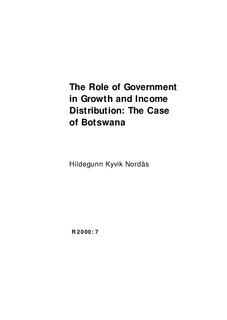| dc.contributor.author | Nordås, Hildegunn Kyvik | |
| dc.date.accessioned | 2008-02-28T08:56:23Z | |
| dc.date.accessioned | 2017-03-29T09:12:04Z | |
| dc.date.available | 2008-02-28T08:56:23Z | |
| dc.date.available | 2017-03-29T09:12:04Z | |
| dc.date.issued | 2000 | |
| dc.identifier.isbn | 82-90584-78-4 | |
| dc.identifier.issn | 0805-505X | |
| dc.identifier.uri | http://hdl.handle.net/11250/2435738 | |
| dc.description.abstract | Botswana has experienced one of the highest growth rates in the world over the past three decades. Growth can, however, be attributed to a long-lived diamond sector boom and the injection of mineral revenue into the economy through government expenditure and government production of goods and services. Botswana has at present one of the highest government expenditure/GDP rates in the world. Still the country has one of the most unequal distributions of income in the world, and the largest discrepancies between economic and social development. This report analyzes the performance of the Botswana public sector, its role in the economy as a provider of public and private goods, its role in income distribution and its activities’ impact on economic growth. It is argued that the government needs to reduce its share in total expenditure by 10-15 percentage points in order to facilitate a transition from mineral and government-led growth to sustained economic growth based on a diversified private sector. Further, it is argued that a more equal distribution of income is imperative for sustained growth. | |
| dc.language.iso | eng | |
| dc.publisher | Chr. Michelsen Institute | |
| dc.relation.ispartofseries | Research report | |
| dc.relation.ispartofseries | R 2000: 7 | |
| dc.subject | Botswana | |
| dc.subject | Government expenditure | |
| dc.subject | Income distribution | |
| dc.subject | JEL classification: H1, H4, O4 | |
| dc.title | The Role of Government in Growth and Income Distribution: The Case of Botswana | |
| dc.type | Research report | |
